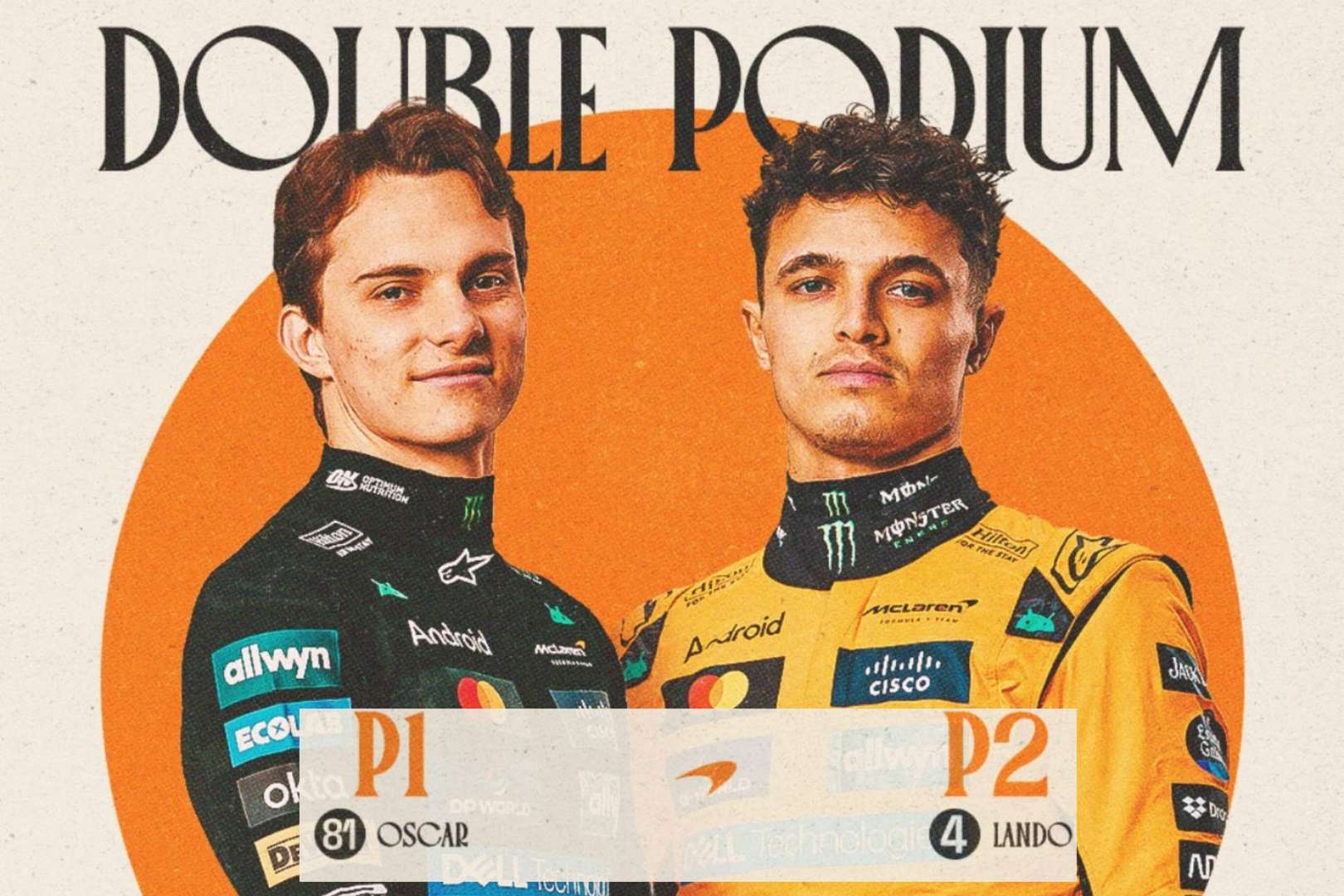Drama.
The Circuit de Barcelona-Catalunya witnessed something extraordinary unfold across 66 laps of pure Formula 1 theater. McLaren’s papaya orange machines dominated with authority that sent shockwaves through the entire paddock. What started as a weekend of quiet confidence transformed into a masterclass of racecraft that will be dissected for months to come.
But was anyone truly prepared for what happened in those final five laps?
Oscar Piastri crossed the finish line with Lando Norris following 2.471 seconds behind, delivering McLaren their most emphatic statement of the 2025 season. The gap between them tells only a fraction of the story that unfolded on Spanish soil.
This was the moment McLaren announced their championship intentions with unmistakable clarity.
Practice Sessions: The Writing on the Wall
Friday’s practice sessions revealed the true hierarchy.
Piastri topped the timesheets with a margin that left seasoned observers reaching for superlatives. His McLaren MCL39 carved through Barcelona’s technical sections with surgical precision that bordered on the supernatural. The half-second advantage over his teammate was a declaration of war against the established order.
Nico Rosberg, watching from the commentary box, struggled to contain his amazement. “Absolutely shocking,” he declared, his voice carrying the weight of someone who understood exactly what such dominance meant. The former world champion described McLaren’s performance as reminiscent of Mercedes during their peak years.
Charles Leclerc extracted everything from his Ferrari, yet found himself nearly a full second adrift. Max Verstappen, the three-time Barcelona winner, languished in fifth position during practice sessions. The RB21 lacked the fundamental pace that had characterized Red Bull’s recent dominance.
Something fundamental had shifted in Formula 1’s competitive landscape. McLaren had found something special, and their rivals knew it.
Qualifying: Precision Under Pressure
Saturday’s qualifying session delivered the expected McLaren front-row lockout. The manner of their achievement revealed fascinating contrasts in driving philosophy.
Piastri claimed his fourth pole position of the season with a lap time of 1:11.546. The Australian’s approach through the final sector demonstrated clinical precision. Every input measured, every apex hit with mathematical accuracy.
Norris followed just two-tenths behind. His journey to second place told a different story.
Their final flying laps showcased contrasting styles that would prove prophetic for Sunday’s race. Norris pushed hard, perhaps too hard, making small errors that cost precious time in the pursuit of that extra tenth. Piastri remained clinical, extracting maximum performance without drama or desperation.
Verstappen secured third place. The gap to pole position exceeded three-tenths. For a driver accustomed to front-row starts and dominant weekends, this represented evidence of a fundamental shift in competitive balance.
The grid was set. McLaren held the advantage. But Formula 1 races aren’t won on Saturday afternoon.
Race Day: When Dominance Meets Drama
The formation lap proceeded without incident. Both McLaren drivers maintained their positions as the field settled into racing formation under the Spanish sun.
Piastri’s start was textbook perfect.
He maintained the lead through the opening corners while Norris held second position with the composure of a driver who understood the bigger picture. Behind them, the battle for third place began immediately, setting the stage for what would become an increasingly dramatic afternoon.
Verstappen attempted an ambitious move on Leclerc at Turn 3. The Ferrari driver defended skillfully, forcing the Red Bull wide and establishing the tone for what would follow.
The early laps unfolded with strategic complexity. Both McLaren drivers managed tire temperatures while maintaining pace. Their radio communications revealed the careful balance between speed and preservation that would prove crucial in the closing stages.
But it was the final five laps that transformed a dominant performance into unforgettable drama.
The Final Five Laps: When Racing Turned Ugly
Lap 59 brought the safety car that would transform everything.
Kimi Antonelli found himself in the gravel trap once again. The Mercedes rookie’s weekend ended in disappointment for the second consecutive race. As marshals cleared the broken W16, the entire field dove into the pits for fresh rubber, emerging with six laps of pure sprint racing ahead.
Everyone fitted soft tires except for one crucial exception. Red Bull gambled on hard compounds for Verstappen, a strategic decision that would prove catastrophic.
The restart unleashed chaos that nobody could have predicted.
Verstappen suffered a massive oversteer moment exiting the final corner as the safety car peeled away. His RB21 slid sideways as Charles Leclerc swept past on the main straight. The Ferrari driver capitalized on Verstappen’s vulnerability with ruthless efficiency.
But the real drama was just beginning.
Verstappen and George Russell made contact at Turn 1 shortly after the restart. The Red Bull driver went off track and used the escape road before rejoining ahead of the Mercedes. The stewards immediately took notice, but the action on track was far from over.
Red Bull instructed Verstappen to hand back the position, prompting an angry response from the Dutchman that crackled across team radio. The four-time champion was not in a mood to comply gracefully.
Lap 63 delivered the moment that would define the entire weekend.
Verstappen backed off going into Turn 5, appearing to follow his team’s instructions to let Russell through. The Mercedes driver moved to complete the overtake around the outside under braking for the left-hander. As Russell drew alongside, Verstappen suddenly accelerated again.
Contact was inevitable.
The collision sent shockwaves through both camps. Russell’s Mercedes suffered damage while Verstappen’s actions drew immediate scrutiny from race officials. The Dutchman eventually allowed Russell through at Turn 11, but the damage was done in more ways than one.
Meanwhile, at the front, the McLaren drivers continued their own private battle.
Norris had closed to within two seconds of Piastri. The championship fight added intensity to every corner. Both drivers showed remarkable maturity, managing the situation without the reckless aggression that was unfolding behind them.
The final laps saw Piastri control the pace with surgical precision while Norris maintained pressure without taking unnecessary risks. Their gap stabilized at 2.471 seconds as they crossed the line, delivering McLaren’s perfect one-two finish.
But the real drama came after the checkered flag.
The stewards handed Verstappen a 10-second time penalty for causing the collision with Russell. The penalty dropped the Red Bull driver from fifth place to tenth in the final classification. What had started as a disappointing weekend for the four-time champion ended in complete disaster.
Weekend Highlights: Stories Beyond the Podium
Lewis Hamilton’s Ferrari debut at Barcelona provided additional storylines that captivated fans worldwide.
The seven-time champion adapted quickly to his new machinery, securing sixth place. His feedback proved valuable for Ferrari’s development program. The Scuderia finally had a driver capable of extracting maximum performance while providing the technical insight necessary for future improvements.
The Racing Bulls team delivered their strongest weekend of the season. Both Isack Hadjar and Liam Lawson scored points in a demonstration of the depth of talent flowing through Formula 1’s feeder programs.
Mercedes showed signs of recovery with Russell’s fourth-place finish. The W16 appeared competitive, suggesting their development direction was finally bearing fruit after months of struggle and uncertainty.
Fernando Alonso’s home race ended in disappointment. The Aston Martin struggled with pace throughout the weekend while Spanish fans had hoped for something special from their hero.
Championship Implications: A Weekend of Consequences
Piastri’s victory extended his championship lead over Norris. The Australian’s consistency has become his greatest weapon in a season where reliability and racecraft matter as much as raw speed.
Five wins from nine races represents a remarkable start to any season.
But the real championship story emerged from Verstappen’s spectacular implosion. The 10-second penalty that dropped him from fifth to tenth place represented a psychological blow that could define the remainder of his campaign.
The Red Bull driver now faces a mountain to climb in the championship standings. His weekend of poor pace was compounded by a moment of poor judgment that cost him dearly. His team must find answers quickly, or risk watching their championship dynasty crumble in real time.
McLaren’s constructors’ championship position strengthened dramatically. Their one-two finish provided maximum points while their main rivals struggled. The gap to Red Bull now represents a significant advantage.
Russell’s fourth-place finish, despite the contact with Verstappen, kept Mercedes in the hunt for podium positions. The W16 showed genuine pace, suggesting their development direction was finally bearing fruit.
Technical Excellence: The Science of Speed
McLaren’s aerodynamic package proved superior around Barcelona’s demanding layout. The MCL39 generated downforce efficiently while maintaining straight-line speed in a combination that proved decisive when it mattered most.
The team’s tire management strategy worked flawlessly.
Both drivers extracted maximum performance from their compounds without excessive degradation. Their pit stops executed with the kind of precision that wins championships. Every element of their operation functioned at the highest level.
Red Bull’s struggles highlighted the competitive nature of modern Formula 1. No team can rest on past achievements. Development must continue relentlessly or risk being left behind by hungrier competitors.
Looking Forward: The Championship Race Intensifies
The European triple-header concludes with McLaren firmly in control. Their dominance at Barcelona sent a clear message to rivals who must now reassess their own championship ambitions.
Next weekend’s Canadian Grand Prix presents different challenges. Montreal’s unique characteristics will test every team’s adaptability. McLaren arrives with confidence and momentum that money cannot buy.
The season’s narrative has shifted dramatically. What began as Red Bull’s championship to lose has become McLaren’s to win. Barcelona provided the clearest evidence yet of this fundamental transformation.
Verstappen’s spectacular implosion provided the weekend’s most shocking storyline. The collision with Russell, the penalty, and the drop from fifth to tenth place represented a complete meltdown from a driver who had seemed invincible just months earlier.
Formula 1’s unpredictability remains its greatest asset. Just when patterns seem established, the sport delivers surprises that remind everyone why millions of fans wake up early on Sunday mornings.
The final five laps will be remembered for McLaren’s masterclass in racecraft and for the moment when a four-time world champion lost his composure completely. Both storylines demonstrated why Formula 1 continues to captivate audiences worldwide.
Barcelona 2025 marked a turning point that will be discussed for years to come. McLaren’s one-two finish was a statement of intent that reverberated throughout the paddock and beyond.
The championship fight has never been more compelling. Verstappen’s weekend of chaos only added to the intrigue.



